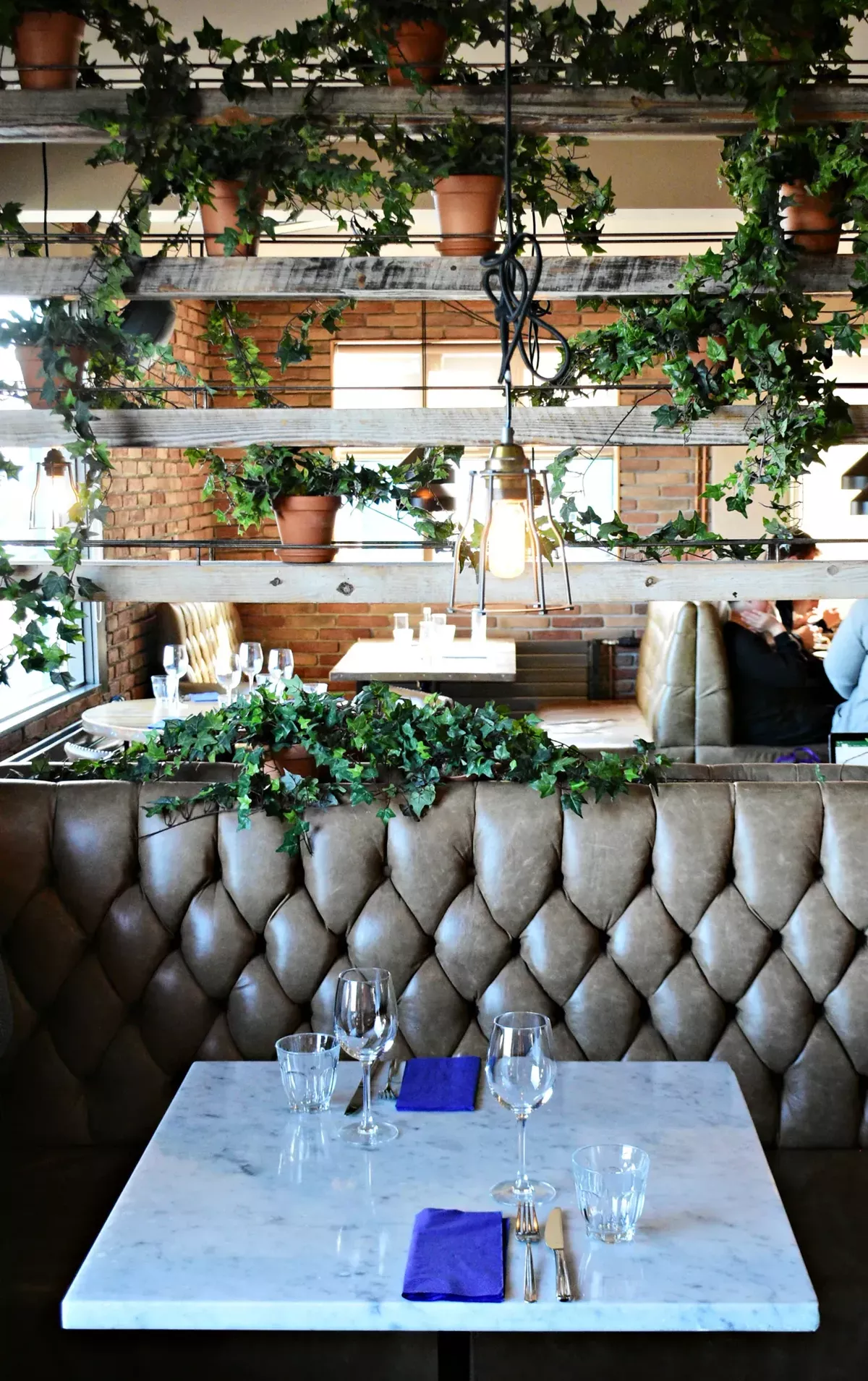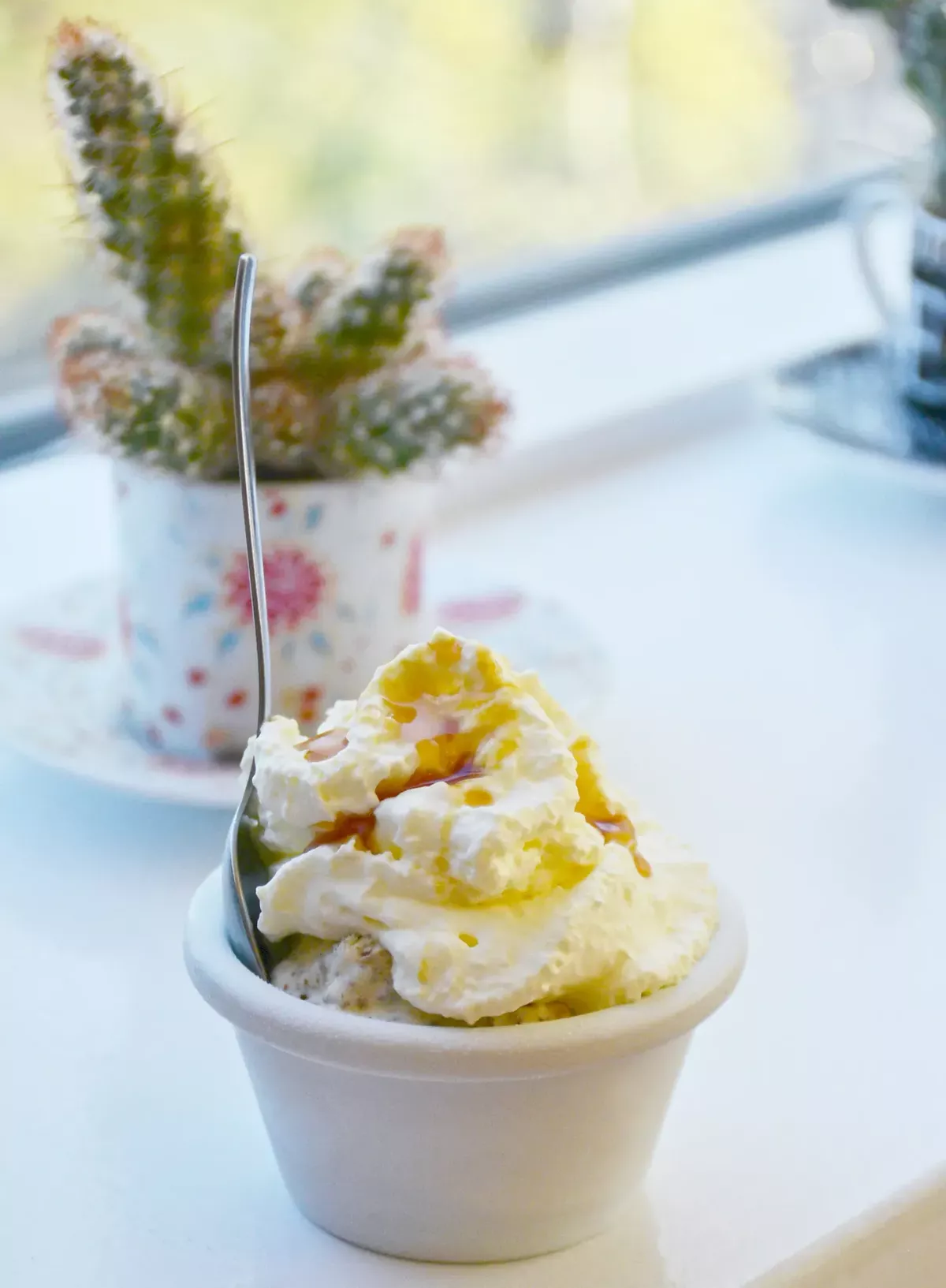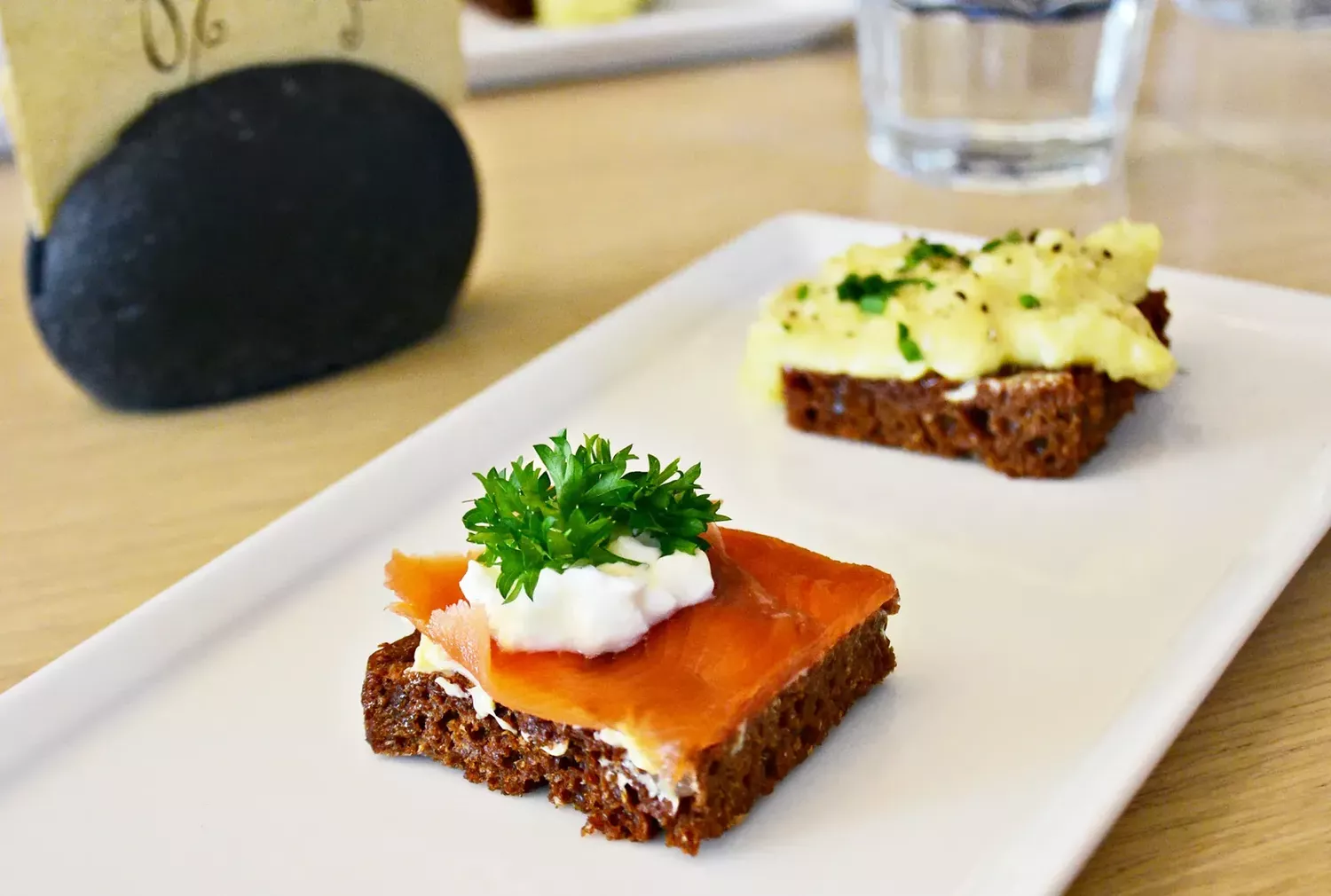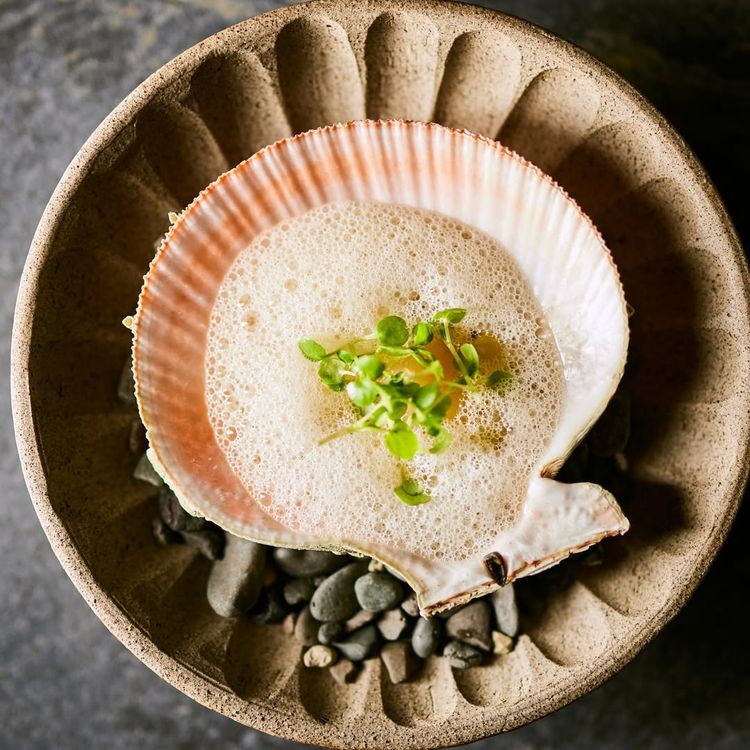Discover Iceland’s unique culinary landscape, from geothermal-baked rye bread to freshly caught Arctic char
Everyone knows about Iceland’s dramatic natural beauty – from the cascading waterfalls thundering down the jagged mountain cliffs to the vibrant, colorful dancing auroras illuminating the Arctic sky, to the icy fragmented glaciers flanked by black sand beaches and rugged lava rocks. But most people don’t have a clue what to expect when it comes to Iceland’s food culture.
Like in most of Scandinavia, the cuisine is entirely inspired by the ingredients Icelanders have around them, from the free-roaming sheep to the cod, herring, and Arctic char that splash around the cold waters. Beyond its freshness, Iceland’s food is pure.
“Our fare has always been very simple because of our climate limitations and isolation from the world. Icelandic food is, in its simple form, uncomplicated, elegant, and natural,” says Egill Halldorsson, co-owner and tour guide of Wake up Reykjavik and the Reykjavik Food Walk.
Related: The bride rewore her grandmother’s wedding dress from 1950 to marry in her hometown of Reykjavík

Reykavik Restaurant. Photo: Courtesy of Claire Volkman
With people visiting the island in droves, Iceland's food scene is experiencing a renaissance. Chefs are taking the freshly caught seafood, the free-roaming lamb, and the abundance of berries growing all over the island and creating fare that rivals that of Copenhagen, Stockholm, and even New York City. Foodies are finding that Reykjavik, the island’s capital, is full of restaurants serving traditional ingredients in new ways. The city’s top places, like Íslenski Barinn, Matarkjallarinn, KOL Restaurant, and Matur og Drykkur, are creating innovative fare like horse jerky, lamb chops with lava salt butter and crispy fish and chips served with a Skyr dipping sauce.
“One of my go-to spots is Dill, Iceland’s first Michelin-starred restaurant, where locally sourced and foraged ingredients are at the heart of each dish like winter dried catfish and charred lamb,” says Black Tomato co-founder Tom Marchant, who holds a special place in his heart for Iceland (it was the first destination the luxury travel planner sold). If you’re looking to go even further off the beaten path, Marchant also points to Torfhús in the countryside as a standout spot. “You can indulge in authentic Icelandic cuisine, from freshly caught salmon to fruits and vegetables grown in greenhouses in a cozy, intimate atmosphere,” he says, noting that the lush mountain views in the summer and glacial landscapes in winter cement the experience as a bucket-list treat.

Photo: Dill
“If you want to experience Reykjavik through food, you need to visit at least one great fine dining restaurant and order the tasting menu. This way you’ll get a different angle and a good insight into the local cuisine from the chefs who have harnessed and pushed it,” Halldorsson says.
Even though local foodies like Halldorsson are doing everything they can to encourage visitors to try dishes that go beyond the “difficult” staples, like fermented shark, lamb brains, or minke whale, a list of famous Icelandic dishes wouldn’t be complete without them.
“Honestly, two of my personal favorite Icelandic dishes are the horse and the whale. Both are incredibly traditional to our cuisine and rarely found elsewhere. Plus, they’re delicious when served as steaks but can also be cured or smoked,” Halldorsoon says. On his most popular tour, the Reykjavik Food Walk, visitors get a chance to sample the cured horse alongside fresh cow’s cheeses and handmade lava salt.
To create the ultimate gastronomic pilgrimage through Iceland’s mystical landscape, we’ve rounded up 12 dishes you can’t leave the island without trying – everything from the infamous fermented shark to the melt-in-your-mouth local chocolates and freshly made breads. Food might not be what brought you to Iceland in the first place, but it’ll definitely be what brings you back.
Reykjavik’s Hot Dog (or pylsur)
Reykjavik's Bæjarins Beztu Pylsur has been in business for over 60 years, serving some of the best Icelandic hot dogs – made from a blend of beef, lamb, and pork. Order it eina með öllu, or with everything, which includes crunchy deep-fried onions, raw onions, sweet brown mustard, and a creamy remoulade. Not just a place for tourists, locals frequent the stand just as much, especially at night after a few cocktails. Pro tips: Order two, since you're bound to gobble up the first one too quickly, and make sure to bring small bills so you don’t hold up the (already very long) queue.
Skyr
If you want to eat like a local, you need to eat Skyr, a thick and creamy dairy product that’s best described as a marriage between yogurt and cottage cheese. Made from pasteurized skim milk and a bacteria culture similar to yogurt, this thick and creamy delicacy is often served with cream and tart berry jam and tastes a bit like Greek yogurt and creme fraiche. Halldorsson grew up eating it with sugar, but most locals love it au natural.

Photo: Courtesy of Claire Volkman
Lamb
“I’d have to say that our Icelandic cuisine completely builds up around our Icelandic lamb,” says Halldorsson. "Our sheep roam around the hills without fences and drink water from glacier rivers and eat plants and berries. Honestly, they marinate themselves naturally with their free-range diets.”
Lamb is served in a variety of ways all around Iceland, sometimes stewed with root vegetables or roasted with a spiced gravy. KOL, one of Reykjavik’s best restaurants, presents their roasted sirloin alongside Hasselback potato, baked oyster mushrooms, and pickled blueberries. For a more traditional dish, try Íslenski Barinn, a casual eatery that serves hearty lamb shank.

Ice Cream and Cheese
“Many of my guests from around the world can't believe that we eat ice cream year around, but we do. We go absolutely bananas for good ice cream,” says Halldorsson with a smile.
There are plenty of good ice cream shops around Reykjavik, like trendy Valdis or mainstay Ísbúðin Laugalæk, offering everything from traditional vanilla gelato to Turkish pepper and black licorice. Get a taste of some of Reykjavik’s best ice cream and their famed rye bread with a scoop of rye-bread ice cream at Cafe Loki, a quirky bistro meets coffee shop right in front of the Hallgrímskirkja, the city’s church and most iconic landmark. If you’re vegan, try Hafís’ dairy-free varieties, like caramel.
Hákarl, or Fermented Shark
You’d be hard-pressed to find any local who would be caught dead trying fermented shark meat, or better yet suggesting it to a foodie tourist, but it's as emblematic of Icelandic cuisine as the free-roaming lamb.
“Although it’s not a part of our daily cuisine anymore, it’s a part of our heritage,” says April Smaradottir, local foodie and guide for Wake Up Reykjavik. “During my grandma’s time, people had to think of how to make food to survive our harsh winters, which could last for months. So we buried it, dried it, smoked it and picked it, left it out to dry for weeks, and soaked it in all kinds of stuff. Access to food was also limited, that’s why we ate things like this,” Smaradottir explains.
Back in the day, the shark was soaked in urine and placed underground to “ferment,” but luckily that practice is outdated. The shark you’ll find in restaurants like Þrír Frakkar Baldursgata is fermented with vinegar and other more natural ingredients and is always paired with a shot of brennivín, also known as black death: a clear, unsweetened schnapps that helps the strong flavor (and smell) of the shark go down smoother.
Rye bread (and butter)
Icelandic rye bread, or rúgbrauð, is a staple of Icelandic cuisine. There are a million ways to eat it: topped with smoked salmon and cream cheese, chopped and blended in ice cream, served with extra creamy butter and crunchy lava salt. However, if you ask any local, there’s really only one way to make it right. It should be buried 30 centimeters in the ground next to a bubbling geyser. Made famous by Sigurður Rafn Hilmarsson, a national icon reigning from the small town of Laugarvatn, the bread is soft (almost spongy) and tastes more like cake thanks to the added sugar he sprinkles in the dough. It takes about a day to cook in a pot underground, but the end result brings thousands of visitors (and locals) to the Golden Circle's Laugavautn Wellness Resort and Geothermal Bakery every year. If you can’t make it to the hot springs, opt for a taste of the delicious bread and the island’s famed butter at Brauð & Co.

Photo: Courtesy of Claire Volkman
Seafood
Families in Iceland almost always had fish for one of their daily meals. Stewed, boiled, fried, roasted, or grilled, fish has been a mainstay in Icelandic cuisine for as long as people have lived there. Delicacies like plokkfiskur, or “mashed fish stew,” kept the locals satisfied during the painfully cold winters. Although times have changed, fish is still a huge staple in many local diets.
Seafood has been a huge economic driver for years and has helped bring the country back to life after the crippling 2008 economic meltdown. Fishing is the largest export in the country, but that doesn’t mean locals aren’t devouring it by the shipful. Cod, salmon, and haddock are the most common, along with langoustines, a favorite for most local gourmands.
“Lobster is also one of the best things Icelanders eat. The small Icelandic langoustine is incredibly tender and delicious and an expensive favorite for many, myself included,” Halldorsson says. Another one of Marchant’s favoyrite spots for seafood is Skál. “Go there for the fresh scallops and pair with their natural wine or local beer,” he suggests.
Fish is found aplenty all throughout Reykjavik, like the gratinated fish with rye bread at Slippbarrinn in the Marina Hotel. Fish even makes an appearance in salty snacks, like Harðfiskur (or fish jerky made from wind-dried cod or haddock), which can be found in almost all grocery stores.
Hangikjöt
If you visit the Nordic island in December, you’ll likely get a chance to try hangikjöt, which is traditional Icelandic food served during Christmas. Usually made from smoked lamb, the meat is boiled and served in slices with sides of potatoes, green peas, and portions of rúgbrauð or flatkaka, also known as flatbread. Back in the ninth and 10th centuries, Nordic travelers started using farm animal excrement as a replacement for firewood when resources grew scarce. After long winters where animals were kept indoors from the cold, Icelanders found a lot of waste, which they dried out in the sun and used to fuel the fires that smoked the lamb meat. But the technique has long since been retired, so if you’re in the area during this festive time of year, hangikjöt is a must-try.
Snúður
Consider a snúður as the Icelandic version of a chocolate-covered cinnamon roll, also known by its cuter name, cinnamon snails, or simply “twists.” The thick icing covers its fluffy bun, and the pastry itself is usually huge, as in size-of-your-head huge. The origin of this baked good is a little muddled but is known to have Scandinavian ties, and its popularity still remains high amongst locals and tourists. Go to Brauð & Co. to try its three different types of snúður, and you'll quickly find that snúður is just the tip of the sweet iceberg of desserts Iceland has to offer. In case your sweet tooth is feeling particularly active during your trip, add a few spots on your food tour and head over to Sandholt for pastries and delicious coffee or Bernhoftsbakari (one of the oldest bakeries in the area) for fresh bread and other tasty finds.
Svið
Although lamb was previously mentioned, svið is a dish that needs its own category. This traditional meal may not be for the squeamish, but it's certainly something adventurous eaters should try once. Svið is made from the sheep's head by splitting it in half, removing the brain singing off the fur, and boiling it for a few hours. It's usually served with sides of vegetables like mashed turnips or potatoes and rhubarb jelly. The sheep's head has a variety of textures and flavors from the tongue to the eyeball, with the general flavour leaning toward mutton.
Similar to hangikjöt, svið is a meal often served during a specific time of year. You'll usually see it at the Icelandic midwinter festival known as Þorrablót, which takes place around mid-January to mid-February. Previously, the celebration was a sacred dinner filled with food, speeches, and poetry to honor the Norse god Thor, or Þórr. Now, Þorrablót can range from large groups gathering for a formal celebration with performances to casual dining among friends and family. If you happen to come across the midwinter festival during your travels, keep an eye out for the svið.
Kjötsúpa, or lamb soup
Hearty and nourishing, Iceland’s traditional lamb soup is quintessential comfort food. Its distinctiveness lies in its simplicity – root vegetables and bone-in lamb shoulder or shank (though other meats are sometimes used) comprise the heart of the soup. It’s made by placing the lamb and water in a pot, bringing to a boil, and simmering until the meat is tender and begins to pull away from the bone. Vegetables are added and sometimes herbs and rice as well. The bones are eventually removed and the meat cut and returned to the pot before ladling the soup into serving bowls.
Pönnukökur
These Icelandic pancakes are similar in texture to a crepe and are typically enjoyed for breakfast, at tea time, and even for dessert – usually with whipped cream and jam. Pönnukökur is traditionally cooked in an Icelandic pancake pan (or pönnukökupanna) and they’re dusted with powdered sugar before stacking to keep the pancakes from sticking to each other. From a broader cultural perspective, Iceland’s history of flour scarcity points to the popularity of pönnukökur, which is made with just a small amount of flour and was typically associated with special gatherings and celebrations.
